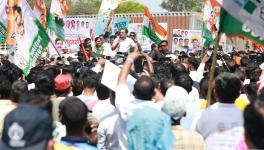A Potent Reminder of our Wilful Failures as a Nation
At least three recently-published Indian-language novels document the rise of oppressive hegemonic majoritarianism in India alongside the resistance to it. Vaidhanik Gulp by Chandan Pandey has been translated into English as Legal Fiction by Bharat Bhooshan Tiwari, Qabar (The Grave), a Malayalam novel by KR Meera, has been rendered into English by Nisha Susan. The latest, Karbala Dar Karbala, a Hindi novel by Gourinath, has sold over 1,100 copies just a month after launch..
Karbala Dar Karbala is located in Bihar’s silk town Bhagalpur of the 1980s, where events culminated in a communal massacre unprecedented in scale. The carnage caused massive displacement from Bhagalpur town and the 250 villages of the district. The novelist was an undergraduate student of science in Bhagalpur during this decade. Gourinath meticulously unpacks the region’s growing communalisation and political economy with mesmerising story-telling and creative liberties. Here is an insiders’ account that benefits from investigative journalistic accounts and reports of government committees and civil rights groups, social science commentaries and essays.
In Hindi-Urdu creative prose, we do not find a strong shahrnama and gaon-nama tradition—accounts of cities and villages—although, in 1987, scholar-journalist Arvind N Das (1949-2000) turned a historical narrative of agrarian and socio-economic changes into a novel. This work is based on 16th and 20th-century Changel, Das’s native village in Muzaffarpur, Bihar.
By the early 1980s, Bhagalpur town had earned considerable disrepute after a series of horrific incidents—the police had started blinding criminals. Unusually for a novel, Karbala Dar Karbala provides references to such events, as Qurratulain Hyder did in her autobiography Kaar-e-Jahaan Daraaz Hai. This makes it a gripping creative narrative with the added profundity of authenticity.
During the 1970s and 1980s, many small towns were in the grips of gangsters. In most such towns, the gangsters and majoritarian communal outfits merged to entrench communalisation at the lowermost levels. This phenomenon has spread recently to villages and remains unexplored by social scientists and novelists. For the mega-city Bombay of the 1980s, Gregory D Roberts wrote his voluminous novel, Shantaram, in 2003. Kathinka Froystad wrote a well-researched historical account in 2005 on Kanpur, Blended Boundaries: Caste, Class and Shifting Faces of ‘Hinduness’.
Gourinath may be the first novelist to pay meticulous attention to a small town prone to communal strife, which prevailed there since the 1920s. His account boldly exposes the villains and heroes of the sordid events. In his cast of characters are politicians, bureaucrats, police officers and criminals, whose real names are used.
The plot revolves around Shiv Jha, a bright student from a village near Forbesganj (Saharsa), who arrives in Bhagalpur to attend college. While writing his MA (History) examinations in October 1989, the city is engulfed in an unprecedented communal massacre that goes on for months and spreads to 250 villages. The police are blatantly on the rioters’ side, leading to massive displacement of Muslims. Local Hindu influentials and toughies grab their land. Zarina, a sharp student, is another central character whose trauma gets revealed in the hours of crisis. As a seven-year-old, she had seen criminals attack the residence of her father, an upright judge who refused to buckle under pressure from a corrupt collector and police chief in Muzaffarpur, Bihar.
When he was a schoolchild in the 1970s, Shiv had noticed anti-Muslim prejudices among his family members and in his village. Already troubled by the inexplicable hatred, he encounters deep-set patriarchy in his village as well. It disturbs him that even the educated, affluent and influential tolerate injustices. A man kills his brother, grabs his properties, exploits his brother’s widow and expels his only nephew. The nephew finds shelter in an old, dilapidated house but is forced to escape and disappear after he marries a poor Muslim girl. Shiv’s older brother has several vices, including exploiting young Muslim girls, but the village influentials never protest.
In Bhagalpur, Shiv closely observes a rising crime graph, the police-gangster nexus and their political patronage by the chief minister and Legislative Assembly Speaker. Both are Brahmins from the same town and involved in intra-party factional fights. Recall that by 1981, Biharsharif (Nalanda) had already gone through episodes of communal violence.
Shiv observes the changing caste of criminals, the composition of gangs and their sudden polarisation along communal lines. The criminals were fattening themselves through contracts for construction, kidnapping for ransom, land-grab and investing their ill-gotten wealth in shopping complexes, cinema halls, transport entrepreneurship, etc. Increasingly, the police were killing criminals from non-elite castes in fake encounters, facilitating elite or dominant caste ideologies. Muslim gangsters were also used to escalate the October 1989 communal conflagration, though the author does not detail their rise or how they met their nemesis.
The novel does not delve into the agrarian distress either, nor the rising Naxalism and academic degeneration of campuses in Bihar after the Jai Prakash Narayan-led Total Revolution in 1974. The rise of saffron forces during their anti-Emergency struggle from 1975 to 1977 and the subsequent Rightward shift of the ruling Congress party, which stoked communalisation, are also vital events beyond the time frame of Karbala Dar Karbala.
Until the 1980s, mofussil universities had considerably vibrant academic and political study and debate cultures inside classrooms and outside, at tea-stalls, river ghats etc. Students in Karbala Dar Karbala notice the majoritarian shift of the Congress party, how it connived with RSS leader Balasab Deoras and the anti-Sikh massacre of 1984. The last event affected Bhagalpur severely. In particular, their Sikh friend, Satvir, is left traumatised and needs the camaraderie and counsel of his family and friends to overcome depression.
The novel owes its title to an outrageous public statement of the district police chief at the time, KS Dwivedi, who has recently retired as the police chief of the province. He threatened Muslims they would be massacred, as happened in Karbala in the 7th century. A professor also tells his students that communal forces may resort to massacre after massacre (Karbala dar Karbala), but history will expose them.
To explain the communalisation of Bhagalpur, which resulted in violence in 1946 and 1967 as well, Karbala Dar Karbala deploys the character of a history professor and the constellation of characters around him. The family of Sarfaraz, a student, is shown to have suffered in each of these communal conflagrations. Finally, in the 1989 violence, he and his remaining family members are wiped out. This was a modern Muslim family with pluralist social interactions and everyday life, although the silk industry and the clan had repeatedly suffered during each communal event in Bhagalpur. They suffered during the Ranchi-Hatia violence of August 1967, too, which had erupted against the demand for Urdu as a second official language.
A small group of bright and progressive students forms a study circle that distributes pamphlets and handbills, organises street plays, holds evening schools in slums, and gets involved in multiple other interventions. Majoritarian student and youth outfits affiliated with the RSS and patronised by the regime made their interventions increasingly ineffective. The Ram Temple movement arrives, and social spaces on and off-campus are communalised through grand public celebrations of festivals and sports. The progressive students are left feeling helpless. According to the memoir in Hindi of then chief minister Satyendra Narain Sinha (1917-2005), an immediate flashpoint for the 1989 massacre was a dispute during a cricket match between teams led by the collector, Arun Jha and the district police chief KS Dwivedi.
Muslim conservatism, patriarchy and communalisation get the least space possible in Gourinath’s novel. Even Zarina’s response to the Shah Bano episode is vague. The Muslim communal outfit Aql-e-Hayat is mentioned only in passing, for example. Liberal and Left secularists are often accused of being soft on Muslim communalism and retrogression, and this novel suffers from this limitation too.
At 60, Shah Bano, born in 1916, was pushed out of her matrimonial home by her husband, an affluent Indore-based advocate, and her sons and daughter-in-law. In 1975, she approached a court in Indore seeking maintenance from her husband. In April 1978, inside the court and before the judge, her husband pronounced instant triple divorce. Thus he used Muslim Personal Law as an instrument to circumvent maintenance. In 1985, the Supreme Court granted Shah Bano a meagre Rs. 179 maintenance.
Meanwhile, Ali Miyan Nadwi and his companions mounted pressure on then Prime Minister Rajiv Gandhi to enact a law against the court verdict. On 15 January 1986, the Momin Conference parliamentarian Ziaur Rehman Ansari extracted a promise from Gandhi to this effect. It was not coincidental that soon after these developments, a Faizabad court ordered the locks of the Babri Masjid to be opened. Within an hour of this verdict, the unlocking was broadcast on the government-owned Doordarshan TV channel. Ali Miyan’s Urdu memoir, Karwaan-e-Zindagi, published in 1988 and Nicholas Nugent’s 1990 book, Rajiv Gandhi: Son of a Dynasty record this event. Karbala Dar Karbala would have benefited if it brought out these facts considering its primary theme is communalism.
Though they are small towns, Bhagalpur and Muzaffarpur contained cosmopolitanism and pluralistic worlds. This novel depicts how crime and communalism forced linguistic identities out of these towns to foist homogeneity on them. It is also a story of persecution and displacement of the Bengalis settled in Bhagalpur, Muzaffarpur and other cities of Bihar. Land sharks, criminals and politicians forced the Bengalis out.
There were several gang shoot-outs inside the Muzaffarpur University campus. In 1983, the notorious gangster Mini Naresh was done to death. A Chandigarh-based Hindi journalist from Muzaffarpur, Kunal Verma, was an eye-witness to some of these incidents. He wrote a six-part report between 25th and 30th September 2018 on the gangsters of Muzaffarpur. By the eighties, the campus hostels had become notorious for storing arms for communal outfits. In February 2018, the RSS chief had camped there, after which there were a series of communal clashes in and around Muzaffarpur.
Bhagalpur is closer to Monghyr, a centre of manufacturing firearms and ammunition. In the seventies and eighties, it was common knowledge in Muzaffarpur that the campus and city were infested with Bhumihar gangsters of Monghyr (particularly Begusarai). It is the majoritarian privilege of narrative making that this caste and campus are never stereotyped. Contrast this with the Muslim-dominated Aligarh Muslim University (AMU), whose campus and even alumni are regularly subjected to stereotyping.
Gourinath avoids these aspects as he focuses on Bhagalpur and the rural landscapes of the adjoining districts from where students, traders and criminals flocked to the city. He devotes a chapter to RSS shakhas and recruitments in the 1980s and its communally discriminatory relief works during the 1987 flood and 1988 earthquake. Reading about this reminded me of Edward Simpson’s 2014 book on Gujarat, Biography of an Earthquake, which exposes the communally motivated and profit-extracting investments of NRI Gujaratis involved in the relief works after the 2001 earthquake.
The novelist disclaims that he is writing of love amid hate and carnage. Fact is, his novel is a brave documentation of our national shame. The victims are often preached at and instructed to forget the persistent massacres and “move on”. Our national conscience refuses to awake when tribes, Dalits and minorities are massacred. The perpetrators usually remain nameless and faceless, and the judiciary often lets them off for “lack of evidence”. Gourinath’s novel is a protest against such misdeeds. Our criminal justice system suffers from chronic ailments, as Warisha Farasat’s 2017 book Splintered Justice exposed.
Karbala Dar Karbala experiments with the novel to fictionalise documented facts with creative finesse and sensitivity. It is a potent reminder of our wilful failures as a nation. It is necessary to read in this harsh and challenging era of state-sponsored divisiveness.
The author is a professor of Modern and Contemporary Indian History at Aligarh Muslim University. The views are personal.
Get the latest reports & analysis with people's perspective on Protests, movements & deep analytical videos, discussions of the current affairs in your Telegram app. Subscribe to NewsClick's Telegram channel & get Real-Time updates on stories, as they get published on our website.
























